


Buick is a division of the American automobile manufacturer General Motors (GM).
Started by automotive pioneer David Dunbar Buick in 1899, it was among the first American automobile brands and was the company that established General Motors in 1908.
Before the establishment of General Motors, GM founder William C. Durant had served as Buick's general manager and major investor. With the demise of Oldsmobile in 2004, Buick became the oldest surviving American carmaker. Buick is positioned as a premium automobile brand, selling vehicles positioned below the flagship luxury Cadillac division.
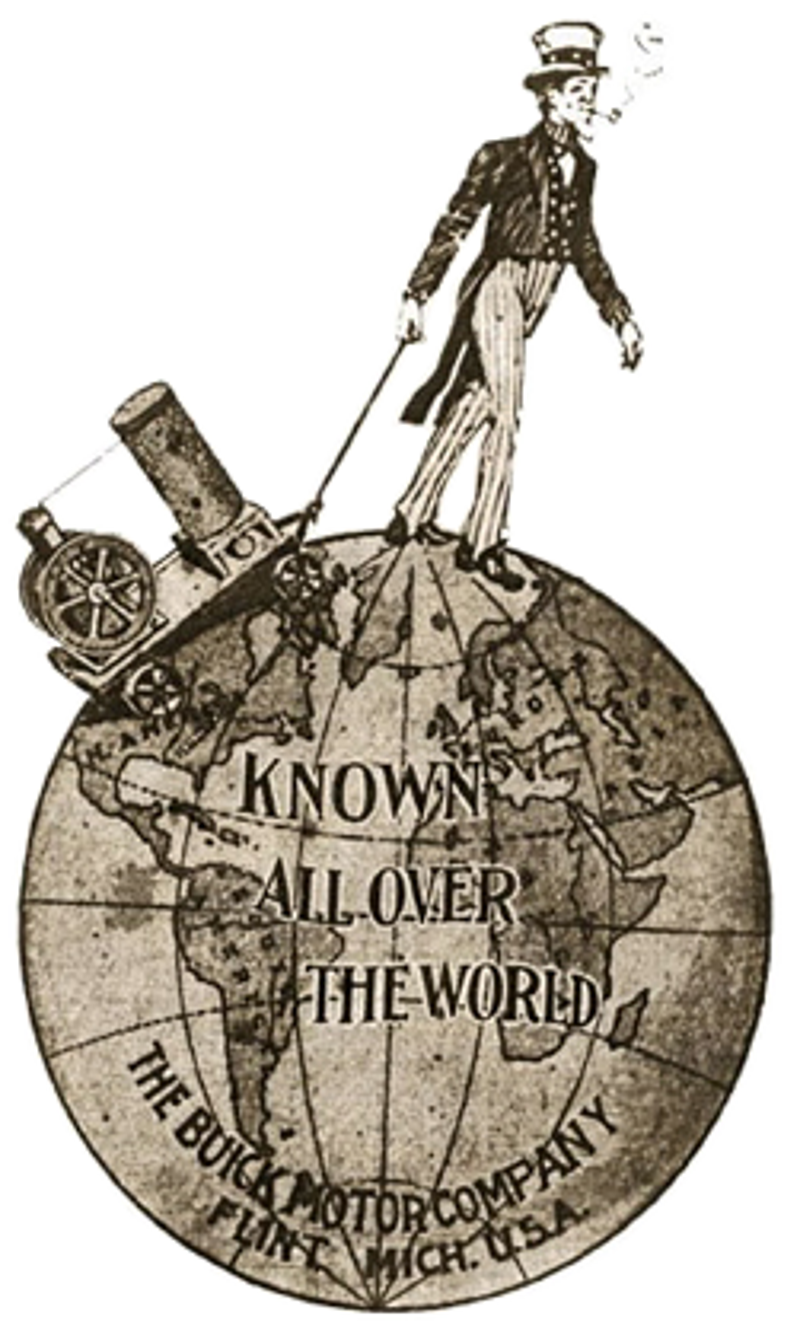
Buick is one of the oldest automobile brands in the world and is currently the oldest in the United States still active today. Autocar, founded in 1897, is the oldest motor vehicle manufacturer in the western hemisphere; while originally an automobile maker, Autocar now builds heavy trucks. Oldsmobile, also an early automaker founded in 1897, is now defunct; Studebaker was founded in 1852, but did not begin producing automobiles until 1902; Henry Ford produced his first car in 1896 but did not start the Ford Motor Company until 1903, and during the period in between was involved with other automobile manufacturers such as Cadillac, founded in 1902.

- David Buick incorporated his company as the Buick Motor Company on May 19, 1903, in Detroit, Michigan.
- Before running out of operating capital William C. Durant was brought in as a controlling investor in 1904.
- In 1908 Durant founded General Motors.
- Buick soon became the largest carmaker in America.

buick 4
The Buick 4 was a series of passenger cars produced by the Buick Division of GM from 1909 through 1918, and was available as a touring car, phaeton or roadster. It was available with the Buick Model B as a larger alternative offering a larger engine and better durability. It became the junior sedan in 1914 when the Buick Six was introduced.

touring

tourabout

runabout
The Model 10 (1908–1910) was equipped with an overhead valve, in-line 2703 cc four-cylinder engine developing 40 bhp. The engine was installed in the front, driving the rear wheels through a transmission shaft.
The gearbox had three forward gears, with the gearshift lever positioned to the right of the driver. The brake pedal came into contact with the Drum brake on the rear wheels. The Model 10 had a wheelbase of 2235 mm and was offered as a 5-passenger touring car, 4-door landaulet or 4-door sedan, manufacturing 23.100.
The Model 10 was an improvement of the previously developed car made by Janney Motor Company and acquired by Buick. The Model 32 (roadster) and Model 33 (touring car) were built in 1911. The only changes were the wheelbases at 2261 mm for the roadster and 2540 mm for the touring car. 1150 Model 32 and 2000 Model 33 were manufactured. It had a listed retail price of US$1,000 ($33,746 in 2024 dollars).
master six

sedan

roadster

touring
The Buick Master Six (also Series 40 and Series 50 depending on wheelbase) was an automobile built by Buick from 1925 to 1928. Previously, the company manufactured the Buick Six that used the overhead valve six-cylinder 4.0 L engine in their high-end cars, and the four-cylinder Buick Four for its smaller, less-expensive model.
After 1924, it dropped the four-cylinder engine and designed a small six, the Buick Standard Six, to replace the Buick Four. The name "Master Six" was introduced for high-end cars sharing the GM B platform with the Oldsmobile Model 30, and were powered by the 4.2 L Buick inline-6 engine released the year before. The yearly changes were a result of a new business philosophy called planned obsolescence.
As GM was sharing platforms and technology within their divisions, the Master Six was related to the Oldsmobile Model 30 with shared wheelbase and engine sizes. Buick had developed a market reputation as being a conservative luxury car, while the Cadillac and the Packard Six were more flamboyant, extravagant and expensive. The last Emperor of China Puyi bought two 1924 Master Six and started the trend of being China's most popular car.
roadmaster
The Buick Roadmaster is an automobile built by Buick from 1936 until 1942, from 1946 until 1958, and then again from 1991 until 1996. Roadmasters produced between 1936 and 1958 were built on Buick's longest non-limousine wheelbase and shared their basic structure with the entry-level Cadillac Series 65, the Buick Limited, and after 1940, the Oldsmobile 98. Between 1946 and 1957, the Roadmaster served as Buick's flagship.
After being resurrected in 1991, the Roadmaster became the marque's largest vehicle, measuring 254 mm longer with a 127 mm greater wheelbase than the C-body Buick Park Avenue. This generation was the first in Roadmaster history to be built on the General Motors B-body platform rather than the C-body, which had traditionally been reserved for GM's largest and most opulent models that were not Cadillacs.
A Buick Roadmaster Estate station wagon was introduced in 1947 and was manufactured in several generations through 1996. The final run of 1991-1996 Roadmasters shared powertrains and platforms with the Chevrolet Caprice, Cadillac Fleetwood, and Oldsmobile Custom Cruiser.

1931-1933
The 1932 Series 80 was the first Buick with the 5650 cc OHV Buick Straight-8 engine developing 104 hp at 2800 rpm. It was positioned as an upper category trim package and shared with the Series 90. The Series 80 was a new approach for Buick by marketing a luxury sedan with an eight-cylinder engine - that became expected from luxury brands

1936-1937
Buick reduced the number of engines from four sizes to two: a 3.8 L, 93 hp version for the Special, and a 5.2 L, 130 hp at 3100 r.p.m engine for the other series.
Buick sales went from just over 48.000 to nearly 158.000.

1938-1939
Styling changes for 1938 were modest, with a longer hood extending to a now nearly vertical grill, taller bumper guards, and redesigned hubcaps.
The engine combustion chambers were redesigned and new "turbulator" pistons gave the engine 141 hp.
The overall automobile market decreased for the year.

1940-1941
In 1940, the Series 80 was renamed Buick Limited. The Roadmaster name was transferred to the new Series 70, which was introduced simultaneously as a brand new Series 50 Super.
The 1940 Roadmaster had a shorter wheelbase, weighed less, and was less expensive than the previous year's model.

1942/1946-1948
The 1942 Roadmaster was longer, lower, wider, and roomier than before (a Harley Earl trademark), due in part to a longer wheelbase.
The Dynaflow was introduced, the first passenger car torque converter transmission. Optional on Roadmaster in its first year, it became standard equipment for 1949. Overall sales were just under 80.000 in both 1947 and 1948.

1949-1953
The Roadmaster received its first major postwar restyling in 1949. Its wheelbase and overall length were reduced, but its weight was marginally increased.
Dynaflow was now standard equipment, and engine output was increased to 150 hp.
A new V8 engine was introduced for 1953, Buick's Golden Anniversary year.

1954-1956
For the 1954 model year, the Buick Roadmaster and Super shared with Cadillac and Oldsmobile 98 the new General Motors C-body, adopting the new "ponton" appearance.
A brand new four-door Riviera hardtop, proved to be the most popular Roadmaster, with 24.770 units sold in 1956.
A padded dash became standard in 1956.

1957-1958
The 1957 Roadmaster featured a lowered body style with an even more panoramic windshield with reverse slanted pillars.
A new 6.0 L engine was rated at 300 hp.
There was a complete restyling for 1959, but this time, the names of the various series were changed. Not until 1991 would there again be a big Buick known as the Roadmaster; the biggest Buick models were renamed the Electra.

1991-1996
The Roadmaster name returned to the Buick line for the 1991 model year after a 33-year absence, with the third generation Buick Estate wagon becoming the Roadmaster Estate. A four-door sedan was added to the Roadmaster line for the 1992 model year, the first rear-wheel drive Buick sedan since 1985. Combined sales showed an over tenfold increase over 1991 thanks in part to an extended production run which had 1992 models going on sale in March 1991.
The standard engine for the 1991 wagon was a 170 hp 5.0 L L03 Chevrolet small-block V8. It was replaced a year later with a 180 hp 5.7 L L05 Chevrolet small-block V8 shared by both wagon and sedan.
riviera
The Buick Riviera is a personal luxury car that was marketed by Buick from 1963 to 1999, with the exception of the 1994 model year.
As General Motors' first entry into the personal luxury car market segment, the Riviera was highly praised by automotive journalists upon its high-profile debut. It was a ground-up design on a new GM E platform debuting for the 1963 model year and was also Buick's first unique Riviera model.
Unlike its subsequent GM E platform stablemates, the Oldsmobile Toronado and Cadillac Eldorado, the Riviera was initially a front engine/rear-wheel drive platform, switching to front-wheel drive starting with the 1979 model year.
While the early models stayed close to their original form, eight subsequent generations varied substantially in size and styling. A total of 1.127.261 Rivieras were produced.

1963-1965
The production Riviera was introduced on October 4, 1962, as a 1963 model, its distinctive bodyshell was unique to the marque, unusual for a GM product.
It had the standard Buick V8 engines, with a displacement of either 6.6 L or 7.0 L, and the unique continuously variable design twin turbine automatic transmission.

1966-1970
The Riviera was redesigned for the 1966 model year. It retained its cruciform X-frame, powertrain, and brakes, but its new body was longer, wider, and 91 kg heavier.
The new front-wheel drive Oldsmobile Toronado shared the Riviera platform, and, a year later, the also front-wheel drive Cadillac Eldorado — the Riviera retaining the rear-wheel drive layout.
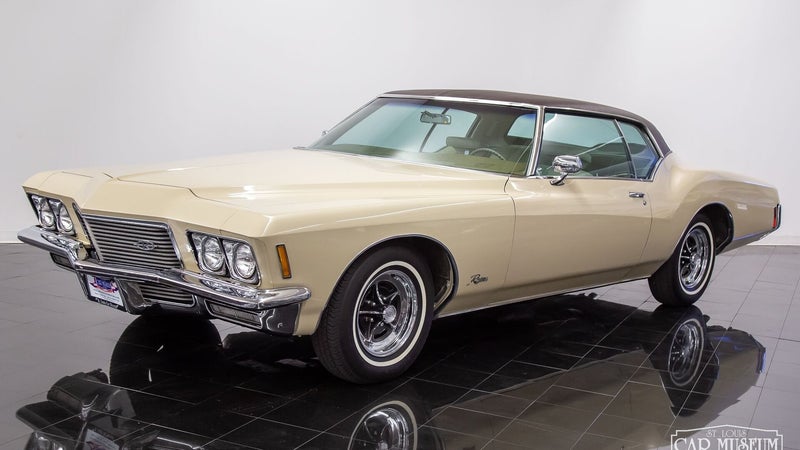
1971-1973
The Riviera was radically redesigned for the 1971 model year with flowing and dramatic "boat-tail" styling. Designed under Bill Mitchell's direction.
The only engine available was Buick's own V8 engine producing 315 hp, with 330 hp with the Gran Sport (GS) package.

1974-1976
Buick replaced its distinctive 'boat tail' roofline with a more conventional-looking "Colonnade" treatment. A landau half-vinyl roof option was available. The tamer-looking Riviera was no lighter, and its standard V8 lost more power, dropping to 230 hp and 245 hp.
For 1975, the Riviera received an updated front fascia

1977-1978
Buick downsized the Riviera for 1977 onto the new smaller GM B platform. It was, in most respects, a Buick LeSabre coupe with unique styling.
Weight was reduced by 300 kg. The engine was replaced by a 5.7 L Buick V8 with 155 hp or an Oldsmobile-built 6.6 L with 185 hp.

1979-1985
Buick prsented the model year 1979 front wheel drive Riviera, its first front-drive production model.
A new turbocharged Buick V6 engine of 3.8 L displacement with 185 hp was available.
Overall sales made the 1980s Riviera a great success, reaching 65.305 for the 1985 model year.

1986-1993
The E-body coupes were converted to unibody construction and transverse front-wheel drive — and was further downsized for 1986. The V6 was now the only engine, fitted with sequential fuel injection (SFI) and was rated initially at 140 hp.
1988 also saw the introduction of Buick's Reatta coupe, a two-seat personal luxury car.

1995-1999
After a hiatus for model year 1994, the Riviera returned for model year 1995 with a complete redesign. The 205 hp naturally aspirated 3800 V6 was the standard engine, with an optional supercharged 3800 V6 rated at 225 hp.
With sales of all coupes declining in the North American market, GM discontinued the Riviera.
electra
The Buick Electra is a full-size luxury car manufactured and marketed by Buick from 1959 to 1990, over six generations. Introduced as the replacement for the Roadmaster lines, the Electra served as the flagship Buick sedan line through its entire production and was offered as a two-door sedan, two-door convertible, four-door sedan, and five-door station wagon.
The Electra initially used GM's rear-drive C Platform, undergoing a significant downsizing for 1977.
For 1991, Buick retired the Electra nameplate, migrating its front-drive premium sedan to the Buick Park Avenue nameplate, previously used as an upper trim level of the Electra itself. The Electra Estate was redesigned, becoming the Roadmaster Estate for 1991.
In late 2022, Buick announced plans to revive the Electra nameplate for its forthcoming 2024 electric models

1959-1960
Following World War II, the Roadmaster constituted the upper echelon of Buick's lineup. For 1958, Buick returned the Limited nameplate (dormant since 1942), slotted between the Roadmaster and the Cadillac Series 62.
For 1959, the Super was renamed the Invicta, the Roadmaster was renamed the Electra and Electra 225, and the unsuccessful Limited model was discontinued. The appearance was shared with two other Buick models.

1961-1964
The Electra, along with the Invicta and LeSabre, was redesigned for 1961 with drastically shrunken fins, and was joined with the all-new compact sized Skylark/Special.
Buick discontinued the Electra nameplate at the end of the 1961 model year, leaving only the Electra 225 starting in 1962.
The large General Motors C-body was used to create the 1964 Electra 225, Buick's richest full-size car. The two-speed Dynaflow automatic was replaced by the 3-speed TH-400 as standard equipment.
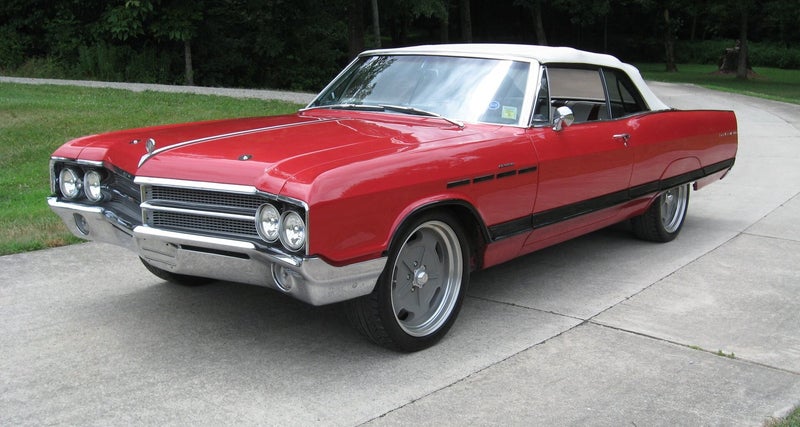
1965-1970
All GM passenger vehicles received a major redesign in 1965 dominated by flowing "Coke bottle" lines and fastback roof profiles on its coupe models, and the 6 window-body style was eliminated.
Engine offerings were unchanged from 1964 including the standard 325 hp V8, and two versions of the larger V8 that were rated at 340 hp or 360 hp.
1969 brought a major restyling to the Electra 225.

1971-1976
Like the other GM brands, Buick completely restyled its B-body and C-body cars for 1971. The full-size cars emerged larger and heavier than ever before or after.
All Electra 225s were hardtops in the 1971 to 1973 model years, eliminating the previous four-door pillared sedan variant and the convertible.
1975 also brought along a newer front end and interior design. Rectangular headlights became standard on all GM C-body cars, along with many others.
All Electras were powered by Buick's 7.5 L engine between 1971 and 1976.

1977-1984
For 1977, a fifth-generation Electra was introduced as GM downsized its C-body full-size lines.
The downsized model brought increased sales, with 161.627 Electras produced in 1977.
For 1985, General Motors downsized nearly all of its full-size lines a second time. Buick, Oldsmobile, and Pontiac shifted to the front-wheel drive C-body and H-body platforms.
Production of the rear-wheel drive Electra ceased in April 1984
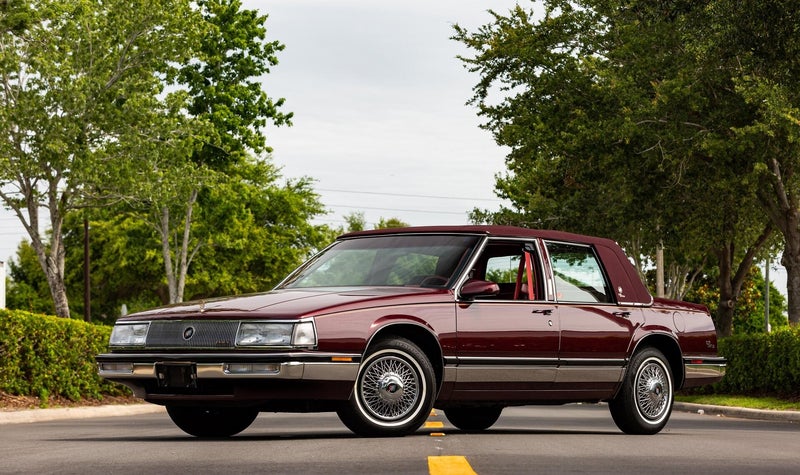
1985-1990
For its sixth and final generation, GM downsized the 1985 Electra, using the company's newly developed C platform shared with the Oldsmobile 98 and the Cadillac Deville. Using unibody rather than body-on-frame construction, the sixth generation was significantly shorter, narrower, lighter and more fuel efficient than the previous generation.
Engines initially included a 3L Buick V6; 3.8L Buick V6, and 4.3L Oldsmobile diesel V6. By model year 1986, Buick would offer only one engine, the 3.8L V6.
regal
The Buick Regal is a line of mid-size cars marketed by Buick since 1973. Serving as the premium mid-size/intermediate car of the Buick product range for nearly its entire production, the Regal initially served as the divisional counterpart of the Pontiac Grand Prix and Oldsmobile Cutlass Supreme; since the late 2000s, the model line has been derived from the Opel Insignia.
Through its production, the Regal has been marketed under a wide variety of body styles, including two-door coupes and four-door sedans (currently in production), along with a 5-door liftback sedan and a 5-door station wagon; the latter (the 2018-2020 Regal TourX) was the first Buick station wagon marketed since the retirement of both the Century and Roadmaster Estates after 1996.

1973-1977
For 1973, Buick introduced the Century Regal as the flagship model of its A-body intermediate line. As with the lower-priced Century Luxus coupe, the Regal shared its notchback roofline with the Chevrolet Monte Carlo, Oldsmobile Cutlass Supreme, and Pontiac Grand Prix. For 1974, the Century Regal adopted a four-door sedan from its parent line, which featured a slightly fastback roofline.
The Regal was most commonly powered by a Buick 5.7 L V8, which was the standard engine for 1973 and 1974.

1978-1987
A downsized Regal appeared for the 1978 model year with Buick's new 196 cu in (3.2 L) V6 engine as standard equipment and a revised version of the venerable 231 cu in (3.8 L) V6 as an option (which became standard for 1980). Initially, a three-speed manual transmission was standard but this was later replaced by an automatic. At the time of introduction, Regals were available exclusively as coupés.
A major facelift for 1981 gave the Regal a much more aerodynamic profile, helping make it possible for the car to compete on the NASCAR racing circuit.

1988-1996
A new Regal appeared in October 1987 on the GM W platform as the first vehicle on that platform; this generation ran with few changes for nine years. Though the new Regal returned to Buick's original concept in being offered only as a coupe and in being aimed once again squarely at the personal luxury buyer, it departed from tradition in being the first front-wheel-drive model, and in having no serious performance option or edition.
Neither a V8 engine nor a turbocharged V6 was offered; the only engine available for 1988 was the Chevrolet 2.8 L V6, producing 125 hp

1997-2004
For the 1997 model year, the Century and Regal once again rode upon the same platform; the revised W platform that was shared with the Oldsmobile Intrigue, the Pontiac Grand Prix, the Chevrolet Lumina and Chevrolet Monte Carlo. The Regal coupe was discontinued.
The North American Regal was replaced in 2005 by the Buick LaCrosse, also built on the W platform.
General Motors and SAIC established a joint venture in 1997 and began assembling the Buick Regal in Shanghai, China in April 1999.

2008-2017
The fifth-generation Buick Regal is a four-door, five-passenger, midsized sedan with a front engine, front-wheel drive layout.
The fifth generation Buick Regal rides on GM's Epsilon II platform and is mostly identical to the Opel Insignia. It first went into production in Germany, in 2008. The Shanghai GM twin of the Insignia was introduced in China as Buick Regal.
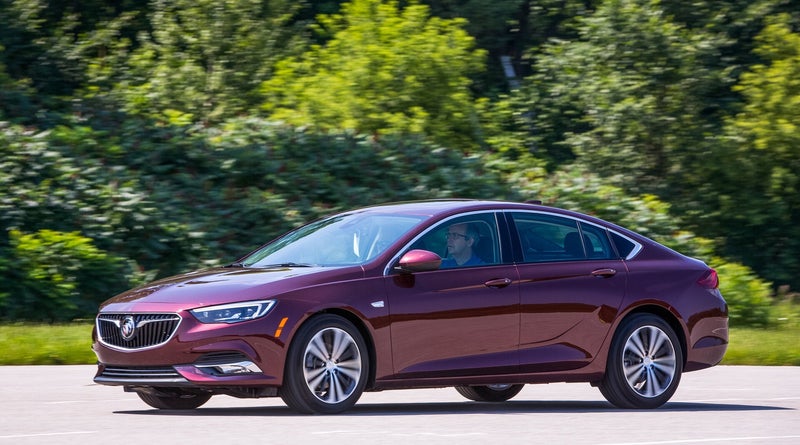
2018-2020
As with the Buick Cascada, the Regal became a captive import, as Buick sourced production of the model line entirely from Opel in Rüsselsheim. Though growing in size, a key objective of the platform update was weight reduction, with 136–227 kg of curb weight removed.
Replacing the previous Regal four-door sedan, the Regal Sportback is a 5-door liftback sedan.
Fitted with a 250hp LTG 2.0L turbocharged I4 engine, the Sportback was offered with either front-wheel drive, 9-speed automatic or optional all-wheel drive.
park avenue
The Buick Park Avenue is a full-size car built by Buick. The nameplate was first used in 1975 for an appearance option package on the Electra 225 Limited. It became an Electra trim level in 1978 and its own model starting in the 1991 model year after the Electra was discontinued.
There were two generations of the Park Avenue that were manufactured in the United States until 2005. In 2007, the nameplate was revived on a large Buick sedan built by Shanghai GM for the Chinese market based on the Holden Caprice from the WM/WN range. The nameplate is derived from the affluent New York City boulevard, Park Avenue.
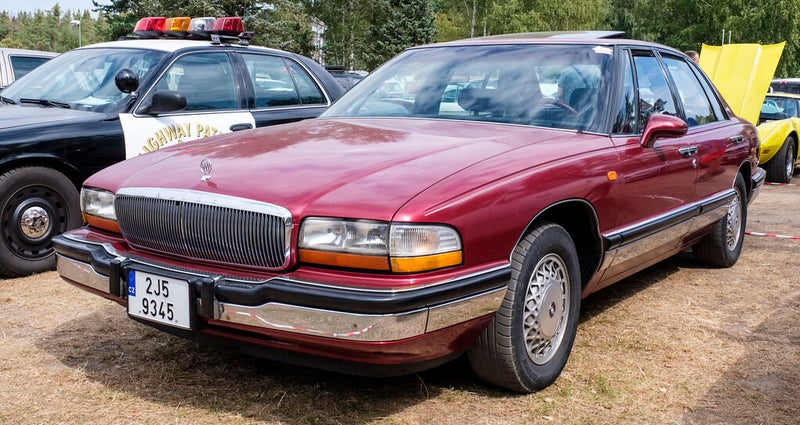
1991-1996
The 1991 Park Avenue, introduced in 1990, used GM's C platform and was previewed by the 1989 Park Avenue Essence show car. Projections were for sales of 100,000 annually.
The Park Avenue was Buick's largest front-wheel-drive sedan, but the even larger rear-wheel-drive Roadmaster returned to the line for 1991 as a station wagon and 1992 as a sedan.
The base-model Park Avenue featured a 3.8 L naturally-aspirated V6 engine and in n 1992, the Ultra came with a 3.8 L supercharged V6 engine.

1997-2006
An updated Park Avenue was released in October 1996 as a 1997 model, using GM's G platform, which was stronger and more substantial than its predecessor.
The new generation was powered by updated Series II variants of the 3800 and as before, only Ultra models were supercharged.
The last 3000 of 7000 Park Avenues carried Special Edition badging that featured the namesake script underneath a silhouette of the New York City skyline. 300 of these were painted with a special two-tone black-on-platinum finish.
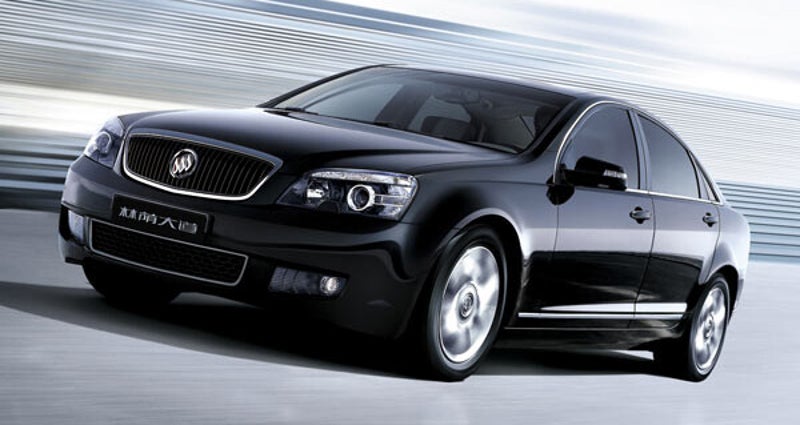
2007-2012
In April 2007, General Motors reintroduced the Park Avenue nameplate in China on a luxury sedan that replaced the Buick Royaum. Like its predecessor, the vehicle is based on the Australian-built Holden Caprice.
The Park Avenue was powered by Australian-built versions of the GM High Feature engine. The standard engines were the 2.8 L LP1 and the 3.6 L LY7 engine available as an option .
The third-generation Park Avenue remained a China exclusive and was never offered by Buick in North America.
lucerne
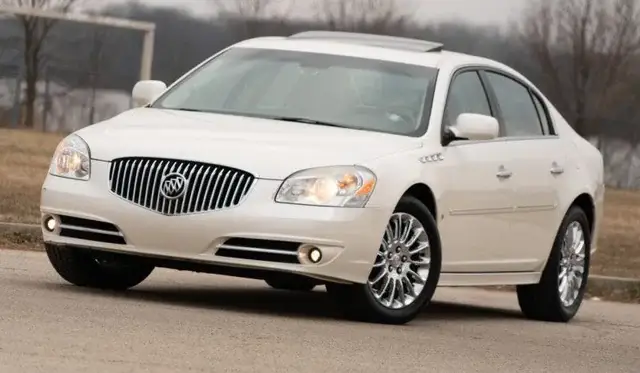


2006-2011
The Buick Lucerne is a full-size car manufactured by General Motors from 2005 to 2011. Named for the city of Lucerne, Switzerland, it served as Buick's top-of-the-line sedan until it was replaced by the second generation Buick LaCrosse. The Lucerne replaced the full-size LeSabre and the Park Avenue in the Buick range, and used a revised G platform.
The Lucerne was introduced with the standard 3.8 liter Buick V6 or optional 4.6 liter Cadillac Northstar LD8 V8 as well as optional active suspension.
The Super trim level was introduced at the 2007 New York Auto Show, featuring the 4.6 liter Northstar L37 V8; revised trim; an increase of 17 hp horsepower, and revised front styling and a rear spoiler.
The last was built on June 15, 2011. The second generation LaCrosse replaced it as Buick's flagship sedan for 2012.
electra e5


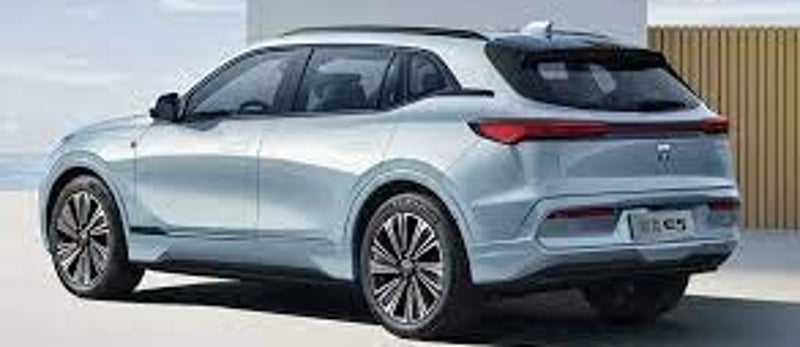
2023-now
The Buick Electra E5 is a battery electric mid-size crossover SUV manufactured by SAIC-GM under the Buick brand.
The Buick Electra E5 is the first product of the Buick Electra electric vehicle series and was introduced during 2023 Auto Shanghai. It was produced by the SAIC-GM joint venture in China since its launch on April 23, 2023. It is equipped with GM Ultium batteries shared with other GM battery electric vehicles, and will be equipped with the Super Cruise driving assistance system.
It is the first vehicle under the Electra sub-brand of Buick electric vehicles, a name reused from the Buick Electra produced between 1959 and 1990.
The Buick Electra E5 is equipped with GM Ultium batteries and the Super Cruise driver assistance system. The model is powered by a 241 hp electric motor with 330 N⋅m peak torque, which accelerates the vehicle from 0–100 km/h in 7.5 seconds, and to a 180 km/h top speed.
concept cars

The Buick Y-Job was a convertible car developed by American manufacturer Buick in 1938. It was the auto industry's first concept car, a model intended to show new technology or designs but not be mass-produced for sale to consumers. Designed by Harley J. Earl, the car had power-operated hidden headlamps, a "gunsight" hood ornament, electric windows, wraparound bumpers, flush door handles, and prefigured styling cues used by Buick until the 1950s and the vertical waterfall grille design still used by Buick today. It used a Buick Super chassis, indicated by the word "Super" located above the rear license plate.
The car was driven for a number of years by Harley Earl, until he replaced it with a 1951 model car. Sometime after that, the car was restored at the Henry Ford Museum, until 1993 when it was returned to the GM Design Center.
Buick has used the name "Wildcat" for multiple concept vehicles. During the 1950s, three Wildcats were designed under the guidance of Harley Earl, including the 1953 Wildcat I, 1954 Wildcat II, and 1955 Wildcat III. The Wildcat I and II still exist today.
Buick used the name again in 1985 for a mid-engine sports car with all-wheel drive and a fully-exposed high-performance, double overhead cam V6. The chassis used carbon-fiber and vinyl-ester resin and the body featured a 'lift-up' canopy for entry and exit. The 1985 Wildcat is still owned by Buick today and is still operational.


The Centurion name was first used on a Buick concept car in the 1956 Motorama. It featured a red and white fiberglass body, airplane-like interior design, a fully clear "bubble top" roof and the first backup camera in place of a rear-view mirror, although it was never shown to be functional.
This car currently resides in the Sloan Museum at the Flint Cultural Center in Flint, Michigan.
In the late 1950s, GM lacked a personal luxury car to compete with the highly successful Ford Thunderbird—a uniquely styled, two-door that had dramatically increased in popularity when expanded from a two-seater to a four-passenger car and the Chrysler 300C. To fill this gap, an experimental Cadillac design, the XP-715, was created, dubbed the "LaSalle" after a former GM luxury marque. Its angular look was reportedly inspired by GM styling chief Bill Mitchell's visit to London during the period, when he was struck by the sight of a custom-bodied Rolls-Royce. He later said that "knife-edged" styling was what he wanted for the new model, but with a lower profile. The design itself was penned by stylist Ned Nickles.
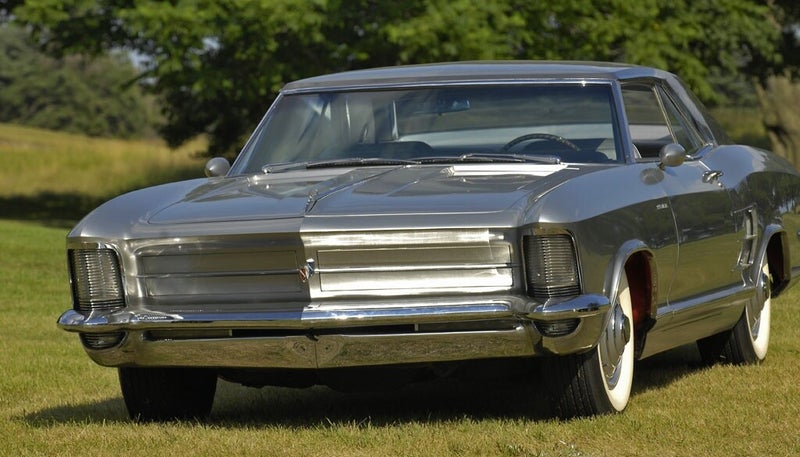








Create Your Own Website With JouwWeb